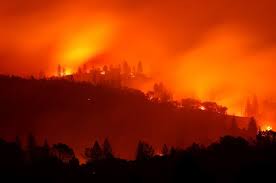Why do wildfires recur in California?« Back to Questions List
|
California is hit again by two devastating wildfires in November 2018. California witnessed a series of large wildfires in July-August 2018 that included Carr Fire and the Mendocino Complex Fire. The wildfires in California in November 2018 caused by Faehn winds include highly devastating Woolsey Fire and Camp Fire. The experts suggest that destructive recurring wildfires in California are the outcome of many combined causes. The major causes cited are climate changes, greenhouse gas emission, shifting population, malfunctioning of equipment, downed power lines, careless campers, climate and weather conditions of California. Whatever be the causes, the data shows an alarming position. Of the 10 largest fires since 1932 in the history of California, nine have occurred since 2000, five since 2010 and two in 2018 alone. The fire season in California is divided into two. The season from June to September presents a combination of warmer and drier weather and is linked to the Western fire season. The wildfires during this season are more inland in higher-elevation forests. The second fire season, identified by Dr. Sun and the research team extends from October to April and is driven by the Santa Ana winds. These fires spread three times faster and burn closer to urban areas. 80 % of economic losses attributes to these fires. Climate change has caused warmer temperatures and extreme variations in snow and rainfall leading to both dry and wet years. California gets most of its moisture in the fall and winter. The vegetation slowly dries out which then serves as kindling for fires. As the dry conditions delay the winter rain, the fire prone season gets extended into late fall. Global warming has caused the temperature to increase by about two to three degrees Fahrenheit. Studies predict that if greenhouse gas emissions and global temperatures continue to rise, the number of wildfires can go up in near future. Growing population has resulted in people occupying flammable places and constructing homes in the line of fire. Shifting of people to areas near forests, known as the urban-wildland interface, is a catalyst for wildfires. It is estimated that 1.8 million houses in the Western United States are situated in high fire prone areas. Studies reveal that 84 percent of wildfires are manmade while the remaining is caused by lightning. Equipment failure and malfunctioning of machines are behind many fires. Carelessness of campers contributes to fires. The fire favorable conditions of California are always waiting for a spark, initiated either by man or nature. During each fall in California, strong gusts known as the Santa Ana winds carry dry air from the Great Basin area of the West into Southern California. The Santa Ana winds dry out vegetation and also move embers around spreading fires. Northern California gets around two inches of fall rains. If the fall rains that usually starts in October is delayed or less, the winds convert already dry condition even drier. This year, the rain was half of normal in many parts leading to sever dry conditions. What is a hothouse state?Green Building and LEED Certification |

